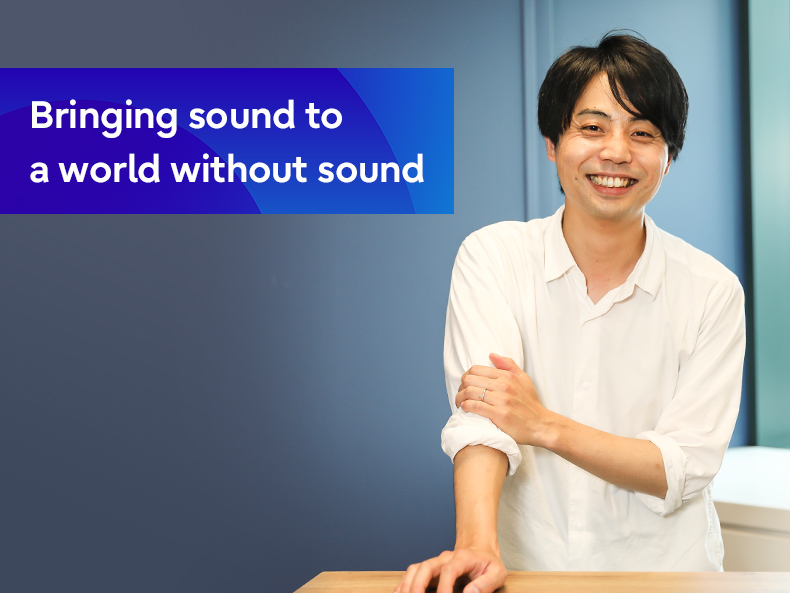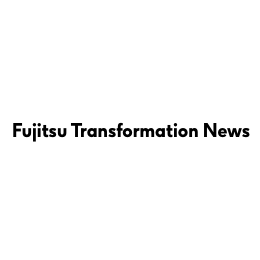In order to realize a society in which everyone can play an active role while respecting each other’s differences, Fujitsu is committed to business activities that respect diversity under the principle of Diversity, Equity & Inclusion. One example is the invention of Ontenna, a device that enables people with hearing disabilities to recognize the volume and rhythm of sound by wearing it on their hair, ears, or clothing collars.
We interviewed Tatsuya Honda from Future Society & Technology Unit, who has been awarded the Imperial Invention Prize for promoting this initiative, about his thoughts on the development and his vision of the future he hopes to realize.
- Table of Contents
-
- The drive for research and development came from the determination to deliver sound to the people with hearing disabilities
- Children’s smiles at the schools for the deaf triggered empathy among supporters
- The expressions on the children’s faces when they experienced the sound of cicadas for the first time is definitely unforgettable
- Received the Imperial Invention Prize—a symbol of the National Invention Awards
- New values and new worlds are created by accepting diversity
The drive for research and development came from the determination to deliver sound to the people with hearing disabilities
――Various efforts are being made to realize a society in which people with and without disabilities can live together without discrimination. How did you become involved in such initiatives?
Honda: I first met a deaf person at a cultural festival in my first year of university. The sign language was very beautiful and a very attractive means of communication to me.
Later, as I gradually learned sign language, I also made friends with those who had hearing disabilities, and we began to enjoy hot spring trips together. One day, when I was walking in the city with a hearing-impaired friend, a dog suddenly barked at us. I was surprised, but my friend next to me was walking as if nothing had happened.
At that moment, I realized a world without sound. I felt uncomfortable with the fact that there are still various sounds in our daily lives that sign language cannot cover and such sounds I hear as a matter of course do not reach people with hearing disabilities, and I cannot share my experience with them. This is how I came to think that I want to bring sound to the hearing impaired.
At the time, I was studying the human body and the extension of the senses at university, and I thought that if the hearing-impaired people could physically feel sound, it would change their world. Some people with hearing impairments rely on sight to live their lives. Such people use other senses to feel the sound that they cannot hear. In this sense, they are perception specialists. We worked on research and development with the specialists in the belief that by working together with them on how to perceive sound, we would be able to share new experience that had never been shared before.
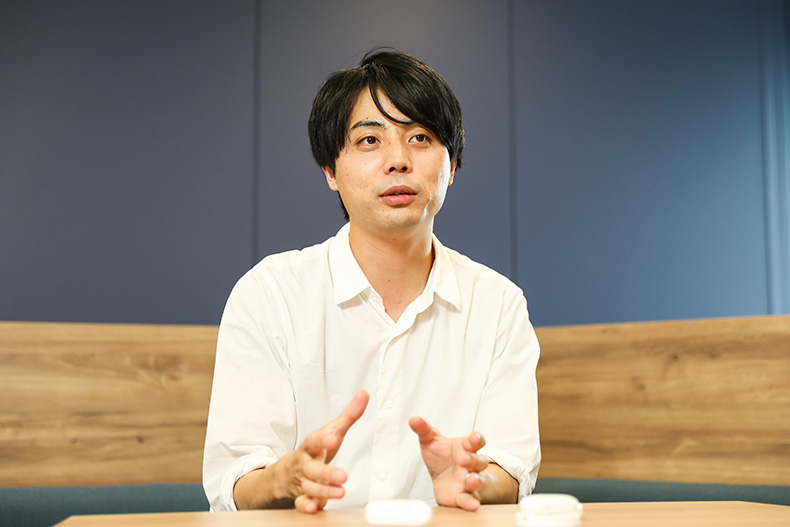 Tatsuya Honda, Future Society & Technology Unit
Tatsuya Honda, Future Society & Technology Unit
――So, your determination led to the research and development of Ontenna.
Honda: Ontenna is a wearable device that convey volume and rhythm of sound to vibration and light. It is used by attaching it to hair, ears, or the collar of clothing. It is simple, but this will help hearing-impaired people to sense the volume and length of sound.
Now, Ontenna are used in more than 80% of schools for the deaf in Japan. We have heard that even children who normally do not speak out much were enjoying the way Ontenna lights up and shakes in response to their voices and have started to speak out more proactively.
It also has the function to control multiple Ontenna simultaneously with a single controller, so that if everyone in a class a wears Ontenna, everyone will be able to feel the same rhythm. This will also allow them to enjoy performances such as dancing and beating drums while feeling the same rhythm.
Children’s smiles at the schools for the deaf triggered empathy among supporters.
――After graduating from university, you started on your research on Ontenna Fujitsu. Please tell us about the background of the project.
Honda: In my second year of graduate school, my research on Ontenna was selected as the Mitou (exploratory) Project*1 hosted by the Ministry of Economy, Trade and Industry (METI) and the Information-technology Promotion Agency, Japan (IPA). This led to inquiries from the public asking where they could purchase the product, and I became strongly motivated to commercialize the product as soon as possible to deliver it to hearing-impaired people. At the time, however, there was no roadmap for commercialization at all. Even under such circumstances, it was Fujitsu that accepted my wishes.
- *1Mitou (exploratory) Project: An initiative sponsored by the Ministry of Economy, Trade and Industry (METI) to discover and develop outstanding human resources with unique ideas and technologies that can create innovative products by making full use of IT, as well as outstanding abilities to utilize these ideas and technologies.
The first mission from Fujitsu was to create a prototype in five months. We worked on R&D and commercialization at high speed. I visited the group company that would make the prototypes and Fujitsu’s in-house designers and met with people to talk about the worldview and vision I wanted to realize to let all parties understand and agree on what I have in my mind. Since it was an in-house start-up, so to speak, it required the cooperation of many different people.
Perhaps these thoughts were understood, and gradually more and more people came to share the same feelings, and I could feel the enthusiasm of these people growing bigger and bigger.
In order to gain more supporters who can relate to the project, we also visited to schools for the deaf together. By seeing how Ontenna is actually used and how it makes children smile, they are more likely to take it personally. I believe that seeing children smiling because of something we have created is the most important way to unite people together as a team and create a chain of empathy. In addition, I also believe that working together with hearing-impaired children—people who will use our products actually—and having the same experience together can lead to new insights and better research and development.
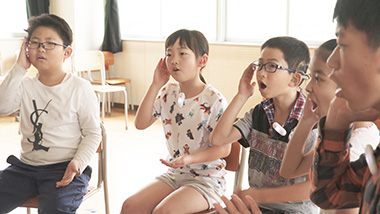
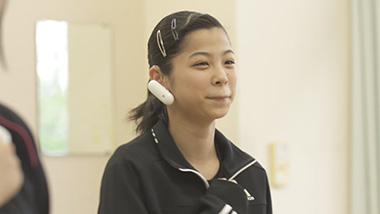
――Did you have any difficulties while developing Ontenna?
Honda: One is the difficulty of productization. Before the current design was decided, we made many prototypes made with people with hearing disabilities. We visited the school for the deaf many times and went through a process of trial and error until we reached a form that the children could wear comfortably. Finally, we came up with the current design that can be worn in the hair, ears, and clothes.
In addition, we received comments from teachers at the school for the deaf that it would be inconvenient to use in class if the battery could not be charged easily, so we have also developed a magnet-type desktop charger that can be charged without inserting or removing the USB cable.
In this way, we proceeded commercialization and development of device that people want to use. Ontenna has now been introduced to more than 80% of schools for the deaf in Japan and used in speech practice, rhythm practice, and STEAM education*2.
- *2STEAM education: Abbreviation for Science, Technology, Engineering, Art, and Math. Education advocated to raise children's interest in creation and technology and to develop skills that will help create future innovation
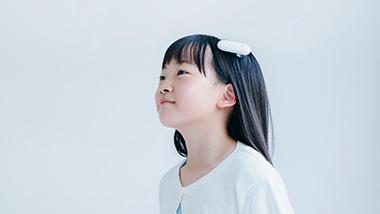
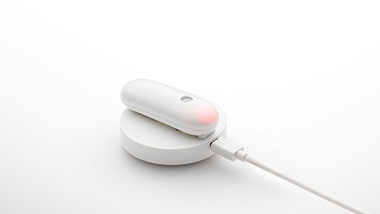
The other was the difficulty of commercialization. It is said that there are about 2 million hearing-impaired people in Japan, but only about 5,000 of them attend schools for the deaf, making it a very small market. However, when we thought about to whom we wanted to deliver Ontenna, the first thing that came to mind was the smiling face of the children at the school for the deaf who use Ontenna. We also thought that experiencing the rhythm of sound, vocalization, and body movement at an early age is very important for brain development and will lead to a better life in the future.
On the other hand, without revenue, the business activity cannot continue. While we were thinking about what to do, we received an offer from a company that echoed our activities to hold an event using Ontenna. We held an event that normal hearing people and people with a hearing loss could have fun together, such as a collaboration between a Japanese drumming performance group and people wearing Ontenna. Gradually, the number of such events increases, and a business model is being created in which Ontenna is created and delivered with the revenue generated from these events.
The breakthrough came when companies and organizations came forward and shared our concept of creating opportunities where both hearing-impaired and normal hearing people can have fun together.
The expressions on the children’s faces when they experienced the sound of cicadas for the first time is definitely unforgettable
――What are your core beliefs as you promote your various activities?
Honda: I have always said that I want to create a society where people can have fun and be happy together, regardless of whether they have a disability or not. We believe that the power of design and technology can make this possible.
For example, the Teshima Art Museum in Kagawa Prefecture held a workshop using the work of an artist named Christian Boltanski. His work, Les archives du coeur (The Heart Archive), contains recordings of people’s heartbeats from all over the world. Although deaf people cannot hear it, Ontenna allows them to experience the thump of the heartbeat through vibration.
In this workshop, children from Teshima Junior High School and Teshima Prefectural School for the Deaf participated to discuss about the artwork via Ontenna. The children at Teshima Junior High School had never met people with hearing disabilities before, but through the workshop they were able to interact with each other. Seeing the children communicating and having fun together through the Ontenna technology, I thought that when the children at Teshima Junior High School meet hearing-impaired people when they grow up, they will be able to treat people with disabilities kindly. We believe that it is very important to use technology to create opportunities for people to think about disabilities.
――What is the most memorable moment during the time you spent with children?
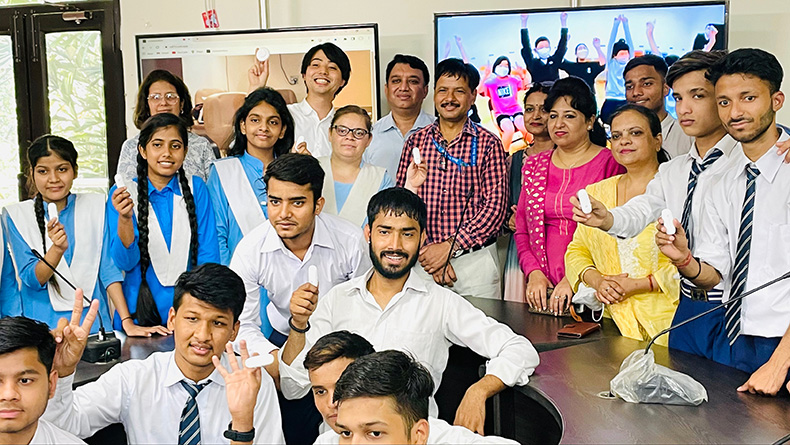 Ontenna workshop at a school for the deaf in India
Ontenna workshop at a school for the deaf in India
Honda: In May 2022, I visited a school for the deaf in India. This project connects schools in Japan and India through workshops using Ontenna. During the workshop, the participants were shown video of cicadas and physically felt the sound using Ontenna. The reaction of the Indian children who felt the sound of cicadas for the first time in their lives at that time remains vivid in my memory. Although they had the knowledge that cicadas make a buzz sound, children could not experience the sound of the cicada. It was a moment when these children could feel a world they had never felt before. When I saw the children’s reaction, I was moved to think, “Oh, this is what I have been researching for.”
Received the Imperial Invention Prize—a symbol of the National Invention Awards
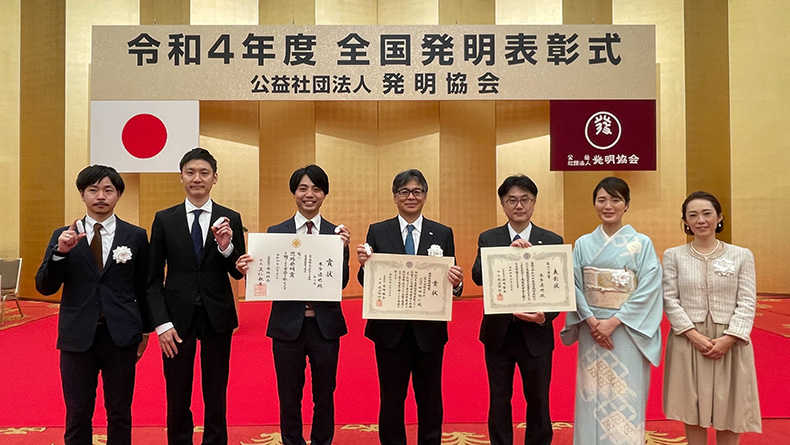 At the 2022 National Invention Awards Ceremony
At the 2022 National Invention Awards Ceremony
――Design of Ontenna won the Imperial Invention Prize. How do you feel about receiving the award?
Honda: I am very grateful to the people around me who have supported me to this point. This award has a long history and many great inventions have received this award, so I am very happy that the design of Ontenna has received this award.
I believe that Ontenna was highly evaluated not only for its design, which we created together with hearing-impaired people and people came along with us, but also for the experience, value, vision, and worldview of using Ontenna.
What is the Imperial Invention Prize?
The Imperial Invention Prize is an award of National Invention Award sponsored by the Japan Institute of Invention and Innovation. The National Invention Award is presented by the Japan Institute of Invention and Innovation with a gift from the Imperial Family to honor inventions, utility models, and designs that have made significant contributions to the improvement of science and technology and the development of industry in Japan, as well as those that are expected to make significant contributions in the future.
Among these, the Imperial Invention Prize is the symbolic award of the National Invention Award and presented to the person who has worked on the most outstanding invention.
New values and new worlds are created by accepting diversity
――What are your future plans for your activities?
Honda: In June 2022, we started a demonstration experiment using the sound visualization device Ekimatopeia at JR Ueno Station. Ekimatopeia is a device that visually expresses station broadcasts and train sounds as letters, signs, and onomatopoeia*3. The idea was based on the children of Kawasaki Municipal School for the Deaf. Not only will this make railroad use safer and more secure for the hearing-impaired people, but we are also hoping that when normal-hearing people see the Ekimatopeia, it can be a good chance for them to reconsider their way of thinking and possibly change their behavior. We are already starting to see changes in behavior, such as station staff learning sign language.
- *3Onomatopoeia: Verbal expressions that express the sounds and voices of the natural world and the state of something (e.g., “vroom,” “ticktock,” etc.).
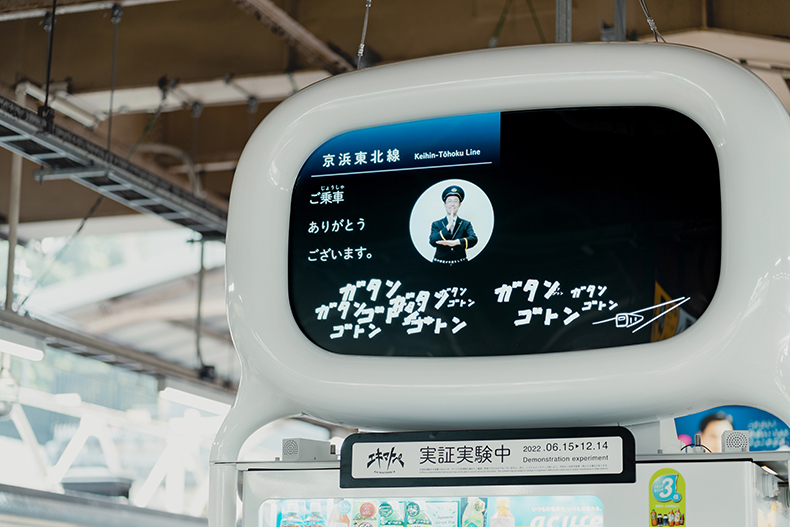 The demonstration experiment is scheduled to run through December. For more information, please visit the Ekimatopeia website.
The demonstration experiment is scheduled to run through December. For more information, please visit the Ekimatopeia website.
Honda: At Fujitsu, we aim to make the company a better place by having each and every employee engage in Purpose Carving to uncover his or her own Purpose (i.e., meaning and purpose of existence). My purpose is to use design and technology to make people smile so, this is also the direction that our future efforts will aim for.
People with disabilities are generally considered to be handicapped in our society, but this is not true. They have special abilities and special senses that compensate for their disabilities. I would like to work with such people to create new things and new experiences.
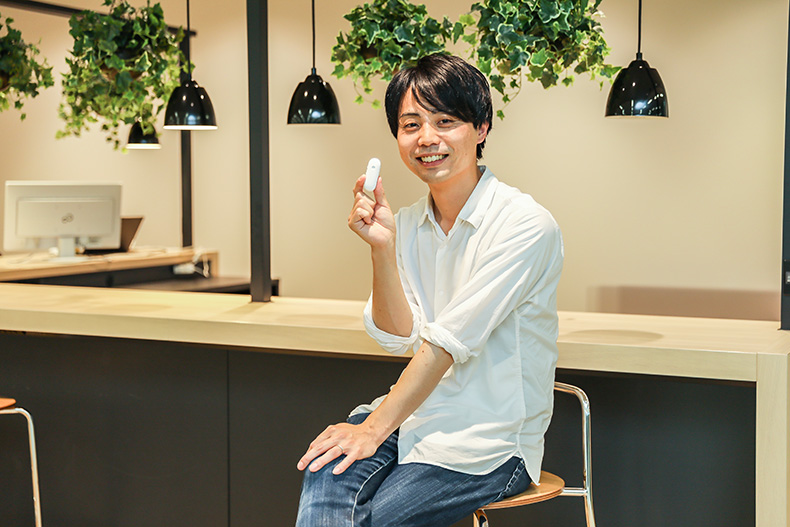 We want to create new values and worlds yet to be seen.
We want to create new values and worlds yet to be seen.
I am sure that researchers and developers are passionate about seeing the results of their research and development because they cannot predict or see the results.
By making the most of each person’s individuality, regardless of disability, there will be many more things that we will be able to see that we cannot see now.
Together with you, we will continue to create new values and a world that has yet to be seen.


